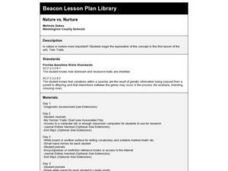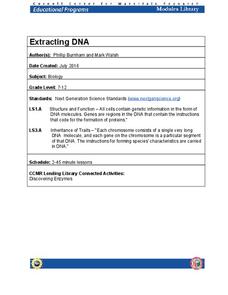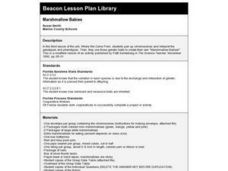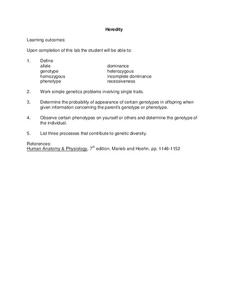Curated OER
Monohybrid Punnetr Squares
Students explore Punnett squares and illustrate specific genotypic and phenotypic genetic outcomes. After a class discussion, students predict the probability of a specific trait being passed on by using Punnett squares. They reveal the...
Curated OER
Dihybrid Punnett Squares
Students construct Punnett squares to illustrate specific genotypic and phenotypic genetic outcomes.
Students calculate the probability of achieving specific genotypic and phenotypic genetic oucomes, using dihybrid Punnett squares.
Curated OER
My Family And Me
Students create a family pedigree, relate the laws of inheritance to a family pedigree, and determine certain phenotypes and corresponding genotypes of members in their family.
Curated OER
Chromosomes
In this chromosomes instructional activity, students complete a crossword puzzle with 33 questions about genetic mutation in chromosomes. They identify traits associated with certain genes.
Curated OER
Who Are We? An Introduction to the Life Within Our Bodies
Students examine cell structure, cell division, and the basic structure of DNA. They read and discuss a case study of DNA research, answer discussion questions, role-play the process of mitosis, and complete a DNA Fact or Fiction worksheet.
Curated OER
Nature vs. Nurture
Eighth graders investigate the concept of nature versus nurture in human development through this series of lessons.
Curated OER
A PRICELESS Collection
Students read a story about the life of Russian plant breeder Nikolai I and Vavilov and the national seed bank he established. They research the Irish Potato Famine of the late 1840s and identify the cause for this famine and make...
Curated OER
Living Corn Necklace
Fifth graders explore heredity and observable traits through experimentation. They view several different types of corn and record their observation of physical traits on a class chart. They create a corn necklace by sprouting dried...
Agriculture in the Classroom
A Rafter of Turkeys
How did that turkey get from the early Aztec culture to your table? Learn about the history of wild and domesticated turkeys in North America, as well as their inclusion in Thanksgiving traditions, with a two-part agricultural science...
Serendip
DNA Structure, Function and Replication
Before a cell replicates, its DNA must replicate. Take advantage of a hands-on guided lesson to teach budding scientists how this happens. Using a set of nucleotide cards, learners become the DNA and work to create matching strands...
Cornell University
Extracting DNA
Uncover the basics of DNA structure through exploration activities. Collaborative groups build DNA models and recreate the process of replication. Then, using plant cells such as peas or strawberries, they extract a DNA sample.
WK Kellogg Biological Station
Sounds of Selection
Do you want a creative and fun way to teach about natural selection? Hop to it by turning your middle school princes and princesses into frogs trying to catch as many bugs as possible in a Hungry Hungry Hippos style game. For high...
Curated OER
DNA Extraction from Yeast Cells
Students explore DNA. They work in groups and mix prepared detergent/ salt solution, meat tenderizer solution, Fleischman's yeast and water to extract DNA from yeast. Observations are recorded.
Virginia Department of Education
DNA Structure, Nucleic Acids, and Proteins
What is in that double helix? Explain intricate concepts with a variety of creative activities in a lesson that incorporates multiple steps to cover DNA structure, nucleic acids, and proteins. Pupils explore the history of DNA structure,...
Curated OER
Marshmallow Babies
Eighth graders interpret the genotypes and phenotypes, then pair up chromosomes.
Curated OER
Where Are the Dinosaurs?
Young scholars explore the concept of extinction by studying dinosaurs. In this dinosaur instructional activity, students distinguish between extinct creatures and those that still exist.
Curated OER
ABO Blood Types Worksheet
Blood types and transfusions are explained in reading passages at the top of the worksheet. A chart of blood type compatibility is also provided. Biology students answer comprehension questions and then exercise critical-thinking skills...
Curated OER
Adaptation Worksheet
Adaptation or acclimation? Young ecologists determine which is being exemplified in twenty questions. When teaching about adaptations, make sure to talk about acclimation, a short-term learned response to a change in the surroundings....
Curated OER
Mendelian and Non-Mendelian Heredity
Tenth graders discuss their physical features, and why they look the way they do. They listen as the teacher discusses DNA, alleles, and dominant or recessive genes. Students perform an experiment with different colored markers...
Curated OER
Where are the Dinosaurs?
Learners construct their own diorama based on the life of a dinosaur. In this dinosaur lesson, students create models of dinosaurs and dinosaurs' eggs to explore the life cycle of this extinct species.
Curated OER
Pea Plants Dihybrid Cross
In this dihybrid cross learning exercise, students are given four crosses to complete using punnett squares. They determine the genotypic and phenotypic ratios of the offspring.
Curated OER
Heredity
In this science worksheet, middle schoolers find the answers to various types of heredity problems. They use the sheet to set goals for completing the unit.
Curated OER
The Empirical Challenges of Racial Classification
This lesson plan will help students examine their preconceptions and assumptions about racial categories and understand the impossibility of constructing a consistent system of human racial classification.
Curated OER
The Nash Case -- Identifying, Choosing and Using Genes
Young scholars complete a variety of exercises as they examine the case of the Nash family who conceived one child in order to provide cells that may be used in a cell transplant for a dying sibling.

























